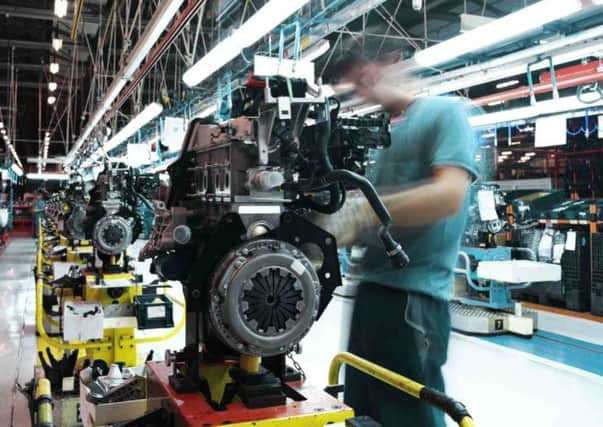Manufacturing bounces back despite weak demand from stagnant eurozone economy


The fall in exports is at the fastest pace since January 2013 according to Markit/CIPS Purchasing Managers’ Index (PMI). However despite the troubled eurozone economy manufacturing grew by 1.7 per cent from September to 53.2, its highest level since July.
Growth comes off the back of strong domestic demand as export orders continued to contract for a second successive month and at a more aggressive rate.
Advertisement
Hide AdAdvertisement
Hide AdCommenting on the figures, Martin Breck, senior economic adviser to the EY Item Club, said: “Sterling’s strength against the euro and the ongoing travails of the eurozone economy continue to hit exports, but the healthy state of the domestic economy appears to be providing some compensation for overseas weakness.”
Yorkshire manufacturers welcomed the news of growth with cautious optimism.
George Kilburn, chief executive of The Company of Culters in Hallamshire, said: “This is obviously to be welcomed it shows the economy is growing but we mustn’t be complacent.
“We need to work continuously to ensure we remain competitive in every area, this remains the focus of the manufacturers I speak to in Sheffield.”
Advertisement
Hide AdAdvertisement
Hide AdOne of the major driving forces behind the increase in manufacturing is down to the fall in commodity and oil prices.
David Noble, chief executive at the Chartered Institute for Procurement & Supply (CIPS), said: “A drop in commodity and oil prices especially has given the sector an advantage in tackling any outstanding orders and improving the pace and delivery of any new work.”
Along with the eurozone, demand was also weak in other markets such as the US and China, which contributed to the contraction in exports in October.
The survey showed weak price pressures, with prices charged by manufacturers rising at the slowest rate for 16 months. Input prices though fell for a second month running.
Advertisement
Hide AdAdvertisement
Hide AdOverall the survey makes for pleasing news, especially when the recent stream of weaker growth is taken into consideration. But manufacturers are finding it tougher than they did earlier in the year.
Felicity Burch, senior economist at Engineering Employers Federation (EEF) told The Yorkshire Post that despite the eurozone crisis “companies are still relatively optimistic for the future over the next three months.
“If we look at sectors that sell predominantly to consumers and construction they are really doing well.”
She added: “The first half of the year was really strong. We were expecting it to be a bit softer in the second half of the year.
Advertisement
Hide AdAdvertisement
Hide Ad“We expect growth of 3.3 per cent this year - that will be the strongest growth since 2010. But there is still a bit of a hill to climb, with it still being 4.2 per cent below pre-recession levels.”
Rob Dobson, senior economist at Markit, welcomed the report as a “positive-marker for the start of the final quarter.”
But he warned that the “sector will only remain a modest contributor to broader economic growth”. On whether the effects of growth were being felt by Yorkshire’s manufacturing firms, Mr Kilburn said: “I think it varies enormously from firm to firm, some are booming and some are struggling.
“It is a varied picture and it dependes on the particular sector they are operating in.
Advertisement
Hide AdAdvertisement
Hide Ad“The region is immensely important, we are now in an area where in innovation and quality, in particular the Sheffield region has a very good reputation in this regard.”
Employment levels in the manufacturing sector also increased, especially in SMEs.
Mr Noble said: “As demand increased, so SMEs reacted to the changing landscape with a more agile response to developing employment capacity, whereas larger companies kept their staffing levels steady.”
But the rate of growth in employment in the sector remains a concern, as this was the second weakest after August since mid-2013.
Advertisement
Hide AdAdvertisement
Hide AdAs the Bank of England Monetary Policy Committee meets on Thursday - these better than expected figures are unlikely to convince them to raise interest rates above the current 0.5 per cent before mid-2015.
Europe’s factories stagnating
Despite an increase in growth over the past month, the eurozone manufacturing sector remains in a state of near-stagnation.
The PMI reported an increase in growth from 50.3 per cent in September to 50.6 per cent in October. Weak demand continued to restrict growth and employment with levels of new orders declining.
Rob Dobson of Markit said: “The performance of eurozone manufacturing, remained broadly flat at the start of the final quarter, as the sector struggles to recover the traction lost following its mid-year slowdown. Manufacturing is therefore unlikely to provide any meaningful boost to the currency union’s anaemic GDP growth.”